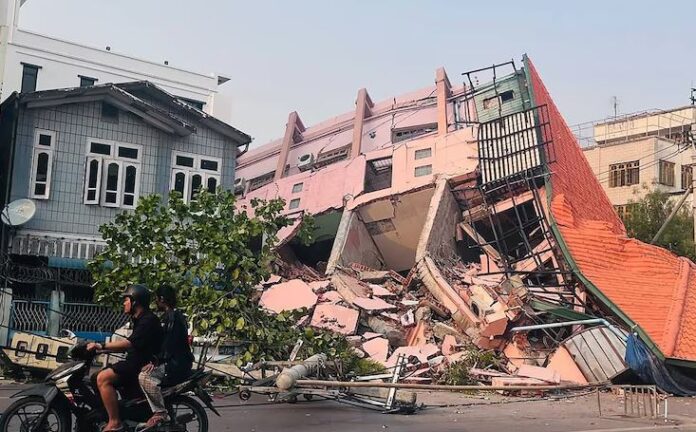Mandalay, Myanmar – The death toll from a devastating 7.7 magnitude earthquake in Myanmar has surged past 1,200, with rescue teams recovering more bodies from the rubble of collapsed buildings near the nation’s second-largest city, Mandalay. The quake, which struck midday on Friday, has left a trail of destruction, exacerbating an already dire humanitarian situation in the war-torn country.

In an official statement, Myanmar’s military-led government reported that 1,232 people have been confirmed dead, with 2,796 injured and 30 still missing. Authorities warned that these numbers could climb further as detailed casualty figures continue to be compiled. The earthquake’s epicenter, located near Mandalay, triggered multiple aftershocks, including a significant 6.4 magnitude tremor, causing widespread damage—toppling buildings, buckling roads, collapsing bridges, and breaching a dam.
Also Read: Russian Drone Strike on Dnipro Leaves Four Dead, 19 Injured

Myanmar’s ongoing civil war, marked by intense violence and a massive humanitarian crisis, has severely hampered relief efforts. The conflict has restricted movement across the country, raising concerns that the death toll could rise sharply as rescuers struggle to reach affected areas.

Regional Impact Felt in Thailand
The quake’s effects rippled across the border into Thailand, shaking the greater Bangkok area—home to approximately 17 million people—and beyond. In Bangkok, authorities confirmed six deaths, 26 injuries, and 47 people missing, primarily linked to the collapse of a 33-story high-rise under construction near the bustling Chatuchak market. The building, being erected by a Chinese firm for the Thai government, crumbled in a cloud of dust, sending panicked onlookers fleeing.

Rescue operations in Bangkok intensified on Saturday with the deployment of heavy machinery to sift through the debris. However, hope is dwindling among families awaiting news of their loved ones. Naruemol Thonglek, 45, tearfully recounted her despair as she searched for her partner, a Myanmar national, and five friends trapped at the site. “I was praying they survived, but seeing this ruin—where could they be? Are they still alive?” she said, clinging to hope.
Waenphet Panta, another distraught parent, said she lost contact with her daughter Kanlayanee, who was working high up in the building when the quake hit. “I’m praying she’s safe, that she’s at a hospital,” she said, sitting beside her husband as they awaited updates.
International Response Grows Amid Local Challenges
In Myanmar, the government reported an urgent need for blood donations in the hardest-hit regions. Leader Min Aung Hlaing signaled an openness to international aid—a notable shift for a country historically hesitant to accept foreign assistance. Relief efforts are already underway, with a 37-member team from China’s Yunnan province arriving in Yangon on Saturday with earthquake detectors, drones, and supplies, according to Xinhua. Russia dispatched two planes carrying 120 rescuers and aid, Tass reported, while India contributed search-and-rescue and medical teams along with provisions. Malaysia plans to send 50 personnel on Sunday to assist in the worst-affected areas.
The United Nations has allocated $5 million to kickstart relief operations, while U.S. President Donald Trump pledged American support on Friday. However, experts expressed skepticism about the U.S. response, citing the Trump administration’s significant cuts to foreign aid, including reductions to USAID programs that have already strained UN and NGO efforts in Myanmar.
As rescue operations continue and the full scope of the disaster unfolds, the people of Myanmar and Thailand brace for a long and challenging recovery, with the specter of further loss looming large.
Key Points: Myanmar Earthquake and Regional Impact
- Death Toll Rises in Myanmar: A 7.7 magnitude earthquake struck near Mandalay, Myanmar, on Friday, March 28, 2025, with the death toll exceeding 1,200. Over 2,796 people are injured, and 30 remain missing, with numbers expected to rise as more data is collected.
- Widespread Destruction: The quake and its aftershocks, including a 6.4 magnitude tremor, caused buildings to collapse, roads to buckle, bridges to fail, and a dam to burst near Mandalay, Myanmar’s second-largest city.
- Civil War Complicates Relief: Myanmar’s ongoing civil war has hindered rescue and relief efforts, limiting movement and raising fears of a sharply increasing death toll amid an existing humanitarian crisis.
- Impact in Thailand: The earthquake affected Bangkok, killing six, injuring 26, and leaving 47 missing, mostly from a collapsed 33-story construction site near Chatuchak market. Rescue efforts continue with fading hope for survivors.
- Personal Stories: Families like Naruemol Thonglek and Waenphet Panta await news of loved ones trapped in the rubble, expressing grief and clinging to hope amid the devastation.
- International Aid Mobilizes: Myanmar’s government has appealed for blood donations and accepted foreign aid. China, Russia, India, and Malaysia have sent teams and supplies, while the UN allocated $5 million. The U.S. pledged support, though its capacity is questioned due to prior aid cuts.
- Challenges Ahead: The disaster’s scale, combined with Myanmar’s conflict and reduced international aid capacity, signals a prolonged and difficult recovery for the region.



